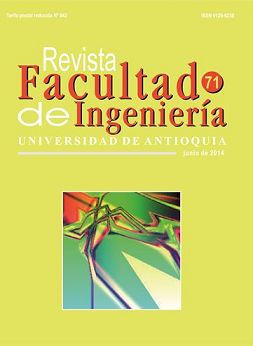Hydrogeochemical assessment and modeling of Morrosquillo Coastal Aquifer (Sucre-Colombia)
DOI:
https://doi.org/10.17533/udea.redin.18086Keywords:
hydrogeological conceptual model, hydrogeochemical modeling, morrosquillo coastal aquiferAbstract
The Morrosquillo coastal aquifer is the main water supply source for the coastal area of the department of Sucre, Colombia. Antioquia University and the Corporación Autónoma Regional de Sucre –CARSUCRE-, water resource manager in this region, carried out a chemical assessment of the groundwater of this reservoir with the objective of validating the flow conditions and defining the model of hydrogeochemical evolution, which was validated using NETPATH inverse modeling software.
Downloads
References
INGEOMINAS. Groundwater map, Sucre departamento, Colombia. Informe interno. Bogotá, Colombia 2002. pp. 120.
E. Karro, A. Marandi, R. Vaikm. “The Origin of Increased Salinity in the Cambrian-Vendian Aquifer System on the Kopli Peninsula, Northern Estonia”. Hydrogeology Journal. Vol. 12. 2004. pp. 424-435. DOI: https://doi.org/10.1007/s10040-004-0339-z
P. Glynn, L. Plummer. “Geochemistry and the Understanding of Ground-water Systems”. Hydrogeology Journal. Vol. 13. 2005. pp 263-287. DOI: https://doi.org/10.1007/s10040-004-0429-y
C. Appelo, D. Postman. Geochemistry Groundwater and Pollution. 4th ed. Ed. A.A Balkema. Rotterdam, Netherlands. 2005. pp. 533. DOI: https://doi.org/10.1201/9781439833544
V. Franco. Geology and geophisic model of the Morrosquillo Gulf. Informe interno. INGEOMINAS. Bogotá, Colombia. 1999.
IDEAM. Guide for Veriments at Surface Water and Groundwater. Ed. Imprenta Nacional. Bogotá, Colombia. 2006. pp. 83.
ESRI. User Manual of ArcGIS. ESRI edition. 2008. pp. 325.
H. Apaydin, F. Kemad, Y. Ersoy. “Spatial Interpolation Techniques for Climate Data in the GAP Region in Turkey”. Climate Research. Vol. 28. 2004. pp 31-40. DOI: https://doi.org/10.3354/cr028031
G. Gutierrez. Environemntal diagnostic of the Morrosquillo aquifer: Litoral zone Tolú – Coveñas. Informe interno. Universidad Nacional de Colombia. Bogotá, Colombia. 2004. pp. 45.
A. Eaton, L. Clesceri, E. Rice, A. Greenberg. Standard Methods for the Examination of Water and Wastewater. APHA-AWWA. Baltimore, USA. 2005.
L. Araguas, P. Aggarwal. Introduction to Water Sampling and Analysis Dor Isotope Hydrology. IAEA. 2007.
J. Hem. Study and Interpretation of the Chemical Characteristics of Natural Waters. USGS Water-Supply Papers. WSP 2254. 1992. pp. 263.
E. Custodio, R. Llamas. Underground Hydrology. 2nd ed. Ed. Omega Editores. Barcelona, España. 1996. pp. 584.
I. Chevotareb. “Metamorphism of Natural Waters in the Crust of Weathering”. Geochim Cosmochim. Acta. Vol. 8. 1955. pp. 22. DOI: https://doi.org/10.1016/0016-7037(55)90015-6
C. Patalas, I. Diamantis. “Origin and Distribution of Saline Groundwaters in the Upper Miocene Aquifer System, Coastal Rhodope Area, Northeastern Greece”. Hyidrogeology Journal. Vol. 7. 1999. pp. 305-316. DOI: https://doi.org/10.1007/s100400050204
A. Honslow. Water Quality Data, Analysis and Interpretation. Ed. Lewis Publisher. Florida, USA. 1995. pp. 397.
L. Plummer, E. Prestemon, D. Parkhurst. An Interactive Code (NETPATH) for Modelling NET Geochemical Reactions Along a Flow PATH. USGS Water Resource Investigation Report. Serie 94-4169. Reston, Virginia. 1994. pp.130.
Downloads
Published
How to Cite
Issue
Section
License
Copyright (c) 2018 Revista Facultad de Ingeniería

This work is licensed under a Creative Commons Attribution-NonCommercial-ShareAlike 4.0 International License.
Revista Facultad de Ingeniería, Universidad de Antioquia is licensed under the Creative Commons Attribution BY-NC-SA 4.0 license. https://creativecommons.org/licenses/by-nc-sa/4.0/deed.en
You are free to:
Share — copy and redistribute the material in any medium or format
Adapt — remix, transform, and build upon the material
Under the following terms:
Attribution — You must give appropriate credit, provide a link to the license, and indicate if changes were made. You may do so in any reasonable manner, but not in any way that suggests the licensor endorses you or your use.
NonCommercial — You may not use the material for commercial purposes.
ShareAlike — If you remix, transform, or build upon the material, you must distribute your contributions under the same license as the original.
The material published in the journal can be distributed, copied and exhibited by third parties if the respective credits are given to the journal. No commercial benefit can be obtained and derivative works must be under the same license terms as the original work.










 Twitter
Twitter